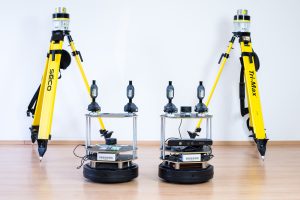Schlagwort: ‘Mobile Robotics’
IGMR Consensus In Sensor Robot Network
Agile and freely networked assembly systems are characterised by the sensoric-supported cooperation of several mobile and stationary robots. However, the dynamic transformation of the production lines demands especial control strategies for robotic manipulators. Fast and reliable motion planning and control schemes should be developed that appropriately react to the changes in the environment and setpoints, and produce feasible motions. These assembly systems can then be mapped into the structure of a meta-model that leads to the creation of digital shadows of the factories of the future.
Contact: Daniel Gossen
Watch the video on our Youtube channel: here.
Automatisierte Aufgabenplanung in industriellen Szenarien
Der an dieser Stelle eingebundene Inhalt führt Sie auf Seiten, die von der von Google betriebenen Seite YouTube - YouTube, LLC, 901 Cherry Ave., San Bruno, CA 94066, USA - zur Verfügung gestellt werden. Mit dem Aufruf des Inhalts kann YouTube Ihre IP-Adresse und die Sprache des Systems, sowie verschiedene browserspezifische Angaben ermitteln. Wenn Sie in Ihrem YouTube-Account eingeloggt sind, ermöglichen Sie YouTube, Ihr Surfverhalten direkt Ihrem persönlichen Profil zuzuordnen. Dies können Sie verhindern, indem Sie sich aus Ihrem YouTube-Account ausloggen. YouTube verwendet Cookies und Tracking-Tools. Die Datenverarbeitungsvorgänge sowie die Zwecke der Verarbeitung können direkt bei YouTube erfragt und eingesehen werden.
Die automatisierte Aufgabenplanung ist eine übergeordnete Steuerungsstrategie, die in Szenarien mit kollaborierenden Menschen und Robotern verwendet werden kann. Diese Strategie ist dazu nötig, um die Akteure und die auszuführenden Aufgaben zu bestimmen, welche zum Erreichen des Ziels ausgeführt werden müssen.
Für das folgende Industrieszenario werden mit dieser Strategie die Aufgaben berechnet, welche durch den Menschen und das FTS, also den beiden Agenten, ausgeführt werden müssen. Am Ende der Ausführung allen geplanten Aktionen sollen alle Gegenstände mit der Handbohrmaschine oder dem Nietwerkzeug bearbeitet wurden.
Die geplanten Aktionen werden zur Ausführung über ein spezielles Framework gesendet, welches in das Robot Operating System (ROS) integriert ist. Jede geplante Aktion wird über so genannte „Action Interfaces“ auf ihre konkrete Ausführung in der Simulation abgebildet. Im industriellen Szenario sind lediglich endliche Zustandsmaschinen als Action Interfaces integriert, wobei deren Zustände Akteur-spezifische Aufrufe an verschiedene ROS-Module darstellen.
Ansprechpartner:
SLAM validation using iGPS
For the validation of localization and mapping algorithms (SLAM) for mobile robots, we use at IGMR the indoor Global Positioning System from Nikon.
SLAM is a classical problem in mobile robotics and still a current and challenging research topic. The current developments are focused in improving SLAM algorithms with respect to a high accuracy, generality, and robustness. For this reason, we validate our SLAM algorithms for mobile robotics with the Nikon iGPS which is used to generate a ground truth with a frequency of 40 Hz and an accuracy of 0.2 mm. In this way, critical inaccuracies and loop closure methods can be much better quantified and analyzed.
Project page:
Bots2Rec
Contact person:
Simon Schläger




